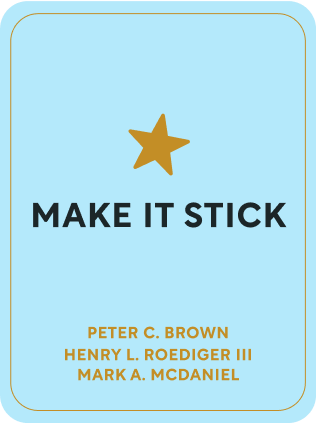

This article is an excerpt from the Shortform book guide to "Make It Stick" by Peter C. Brown, Henry L. Roediger III, Mark A. McDaniel. Shortform has the world's best summaries and analyses of books you should be reading.
Like this article? Sign up for a free trial here .
What is spaced practice? How does spaced practice compare to cramming (learning a large amount of information in a very short period of time)? Which technique is more effective and why?
Spaced practice is a study technique that involves multiple short study sessions spaced out over time. Spaced practice develops your “underlying habit strength,” which prepares you to use that knowledge when you need it. It may feel less productive than cramming initially because you’ve forgotten some of the material and it feels like you don’t have a grasp of it—but that extra effort is precisely what makes the method effective.
Keep reading to learn about spaced practice, why it works, and some methods for spacing out your study sessions.
Why Does Spaced Practice Work?
When you learn something new, your brain undergoes a process of consolidation, which can take hours or days. Spaced practice gives your brain the time it needs to strengthen the new knowledge and store it in your long-term memory through consolidation.
Additionally, the effort of retrieving the knowledge from your last practice session triggers reconsolidation, further embedding the information.
Many people resist spaced practice because it doesn’t give them the immediate gratification of seeing improvements as they practice that comes with massed practice, which scientists call “momentary strength.”
However, that feeling belies the fact that momentary strength quickly fades, because massed practice stores information in your short-term memory.
Two Methods of Spaced Practice
There are two methods that improve comprehension and retention while organically spacing your practice.
Interleaved Practice
One way to space out your practice and improve your retention is by interleaving, or mixing up your practice among multiple related topics or skills. Interleaving improves your comprehension and retention in two ways:
- Switching among different topics naturally spaces out your practice in any one area.
- Changing your focus among related topics helps you make connections among them, which deepens your understanding of each subject.
The key to interleaving is to switch to the next skill or concept before you’ve finished practicing one. It feels counterintuitive and frustrating to switch gears before you’re ready, which is why teachers and students often resist interleaving.
In fact, in contrast to the momentary strength you get from massed practice, interleaving actually hinders your performance while you’re learning the material. However, in the long term, this method still results in better retention.
In one study, college students learned how to calculate the volumes of four geometric shapes. One group of students solved practice problems that were grouped by the shape, while the other group of students solved an interleaved set of practice problems. That day, students doing massed practice performed better, averaging 89% correct answers, compared to 60% among students who did interleaved practice. However, on a test the following week, the students who’d done interleaved practice averaged 63% correct, whereas the other group dropped to 20%.
(Shortform note: Although the interleaved group improved slightly, while the massed practice group dropped drastically, the interleaved group never performed at a level close to the massed practice group’s initial work. The book doesn’t address how the interleaved group could have raised its score overall—perhaps simply by doing more interleaved practice.)
Interleaving simulates and better prepares you for the final test—and real life—where you’ll encounter situations that require a mix of different skills and knowledge.
Varied Practice
Varied practice involves practicing a skill in different contexts, which strengthens your ability to apply that skill to a variety of situations. Varied practice strengthens your understanding of the underlying principles and makes you better at discerning among different contexts to determine the best way to approach a situation.
One study illustrates the effectiveness of variation: Two groups of children practiced throwing bean bags into buckets. The first group practiced only with buckets that were three feet away, while the other group practiced with a mix of buckets that were two and four feet away. After a few months of practicing, everyone was tested on throwing bean bags into buckets three feet away—and the kids who’d practiced on the mix of buckets (none of which were three feet away) far outperformed the kids who’d only practiced on three-feet buckets.
Neuroimages of people learning new motor skills reveal that varied practice engages an area of the brain that deals with more difficult motor skills, while mass practice engages a part of the brain that deals with simpler tasks. This suggests that learning a skill through varied practice produces a more complex mastery, which broadens its applicability.
Similar results have been found in cognitive tasks. One experiment asked a group of students to solve the same anagram (word scramble) repeatedly, while another group of students solved different anagrams that made the same word. When all the students were tested on the anagram that the first group had solved—the only anagram that group worked on throughout the experiment—the students in the second group still outperformed them.
However, when varying your practice, be careful not to slip into blocked practice, which is doing variations in the same order. Blocked practice is like failing to shuffle your flashcards: You get a variety of topics and practice spaced-out retrieval, but encountering them in the same order every time limits the effectiveness.
Interleaved and Varied Practice Improve Your Discrimination
Interleaved and varied practice strengthen your conceptual knowledge of the underlying principles, as opposed to a simple surface-level understanding of facts and figures.
The conceptual knowledge you gain through these methods improves your ability to discriminate, or determine what knowledge or which skill you need in various situations. This is a crucial aspect of using what you learn in real-life situations.
In one experiment, researchers asked participants to study several artists’ paintings so that they could look at a piece of art and be able to identify the painter. Some participants used massed practice, studying each artist extensively before moving onto the next, while others used interleaving and switched among different artists.
Interleaving helped participants see the differences among different artists’ works, as opposed to the commonalities in each individual artist’s works. That ability to discriminate helped them identify who’d painted not only the paintings they’d studied, but also paintings they’d never seen before.
Continue Practicing Mastered Skills
No matter how well you know something, you must continue spaced practice in order to maintain your mastery. Don’t fall into the “familiarity trap,” when you neglect a skill because you feel you’ve got it down pat. The better you know something, the less frequently you need to practice it—but never stop practicing it altogether.
For example, a basketball coach may spend the majority of practices on shooting drills, running plays, and playing scrimmages. But the coach must also regularly drill dribbling and passing, even though they’re basic skills that are ingrained in the players’ repertoire. The players can’t perform the higher-level skills if they lose proficiency in the fundamentals.
Prioritize your practice with flashcards organized in the Leitner system, which naturally spaces your practice. Divide your flashcards into four sections in a box:
- In the first section, put flashcards you struggle with the most. These are the cards you’ll practice most often.
- In the second section, put flashcards you’re slightly better at. You’ll practice these about half as often as the first section.
- In the third section, put flashcards you’re even better at. You’ll practice these less often than the previous section.
- In the fourth section, put flashcards you seldom get wrong. You’ll practice these the least
When you have a wrong answer, move that flashcard up to the next section. When you get a right answer, move the flashcard back a section.

———End of Preview———
Like what you just read? Read the rest of the world's best book summary and analysis of Peter C. Brown, Henry L. Roediger III, Mark A. McDaniel's "Make It Stick" at Shortform .
Here's what you'll find in our full Make It Stick summary :
- How to understand and remember what you learn
- How a little forgetting helps you remember
- Why you’re not a good judge of how much you know






